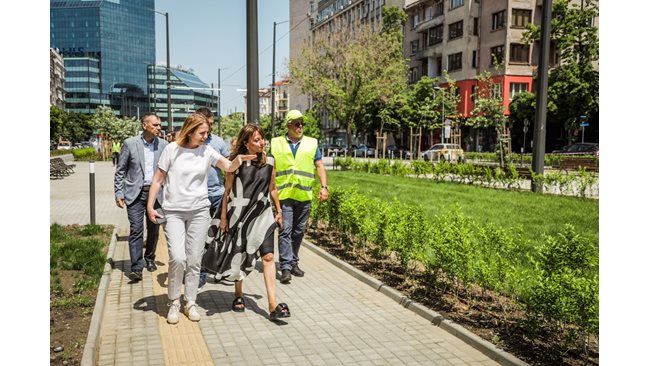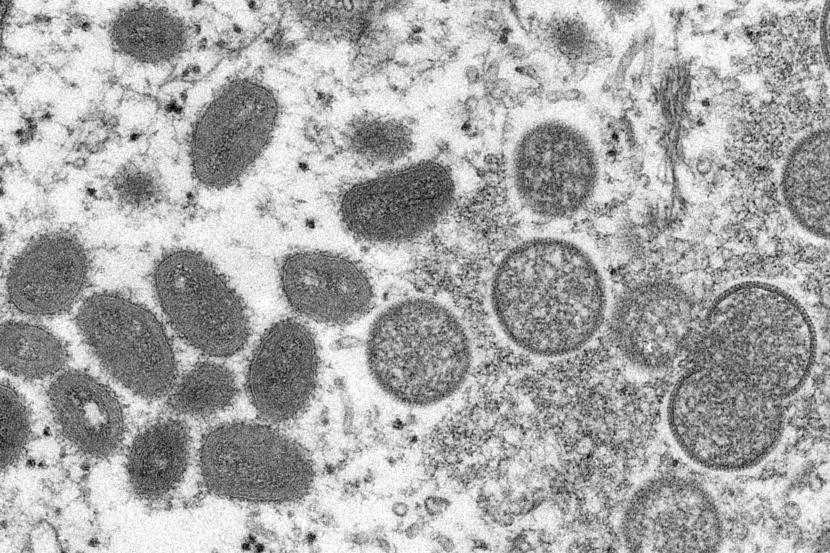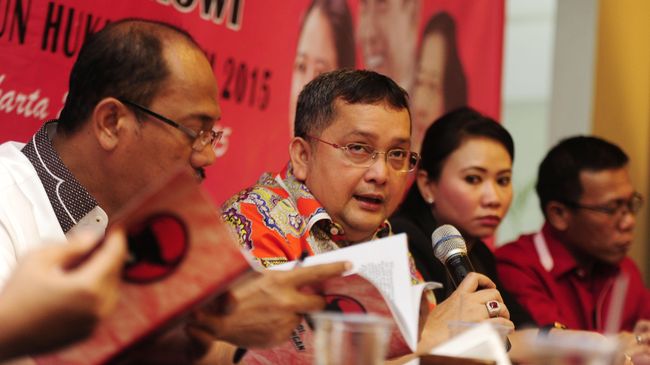The transformation of the space between Macedonia Square and the Russian Monument will bring back pedestrians, children, lovers, says a boss at a famous French architectural studio, the project’s rule.
The first linear park in Sofia will be ready in July. It is currently being built in the area along the tramway between the two iconic central squares of the capital – “Macedonia” and “Russian Monument”.
Yesterday the mayor Yordanka Fandakova and the managing director of “Vilmot and Associa” Borina Andrew inspected its construction. The world-famous French architectural studio is the author of the conceptual design for the improvement of space.
“It’s always good to see ideas come to fruition
and how they transform urban spaces. For me, the most important thing is to bring back pedestrians, children, young people, lovers in this beautiful place.
“With the transformation of space into a linear park, which is happening now, I hope that this goal will be met,” said Andrew.
Most of the construction and repair works have already been carried out.
The tram rails have been completely replaced and tests of the catenary and the track have been made. The space around the rails is grassed. New pedestrian and bicycle lanes have been built, as well as recreation areas. Stop sheds have been installed and horizontal markings have been made. The whole vegetation in the park is planted – over 180 trees,
13,000 bushes and more than 5,000 flowers,
and an irrigation system has been built for its maintenance. Benches, bins, lamps are installed.
A few days ago, the Sofia Municipality received a permit from the National Institute for Immovable Cultural Heritage for renovation activities on the area of 650 square meters, which falls within the scope of the Russian Monument and is therefore a cultural monument. In practice, this will be the last part of the linear park, it will be financed from the municipal budget.
The construction of the new linear park, with the exception of the section, which is a cultural monument, is being implemented by the municipality in the second phase of the project for integrated metropolitan public transport. It is funded by the Operational Program “Growing Regions”.
Borina Andrew, CEO of Wilmotte & Associes Architectes
We designed a temporary “Grand Palais” – 10,000 square meters, made of wood only. Olympic competitions will also be held there
God is in the detail. When one publicly space is beautiful, people keep it. And it is easier to communicate with each other in it
Borina Andrew was born in Sofia. He has lived and worked in France for 40 years. He graduated in Art at the Ecole du Louvre, and International Relations at Science Po and Literature and Communication at the Sorbonne. She was engaged in journalism, publishing, organized cultural missions for the French Ministry of Foreign Affairs. He has been working for the world-famous French architectural studio Wilmotte & Associes Architectes SAS for 18 years. He is first Director of Development and responsible for projects in strategic locations – Italy, Britain, Brazil, Russia, Ukraine and China, contributing to the spread of Jean-Michel Wilmot’s work around the world. He then became CEO. She is a holder of the Order of the Legion of Honor of France and is among the 40 most influential women in France.
– Ms. Andrew, what projects is Vilmot and Assisi currently working on?
– We are completing the UN headquarters in Senegal, which will house 36 agencies. This is a very iconic building – 60,000 square meters, environmentally friendly and has the shape of a water wheel. We have just completed the GRAND PALAIS EPHEMERE project. It is a temporary facility that replaces the Grand Palace in Paris – the exhibition hall built for the World’s Fair in 1900. Now it is under renovation and to continue major events, including the Olympic Games in 2024, was made on Mars field temporary building. It has an area of 10,000 square meters, with a wooden prefabricated structure. We built it in 8 months, it is completely environmentally friendly. The building is already used for all major events related to contemporary or ancient art. Chanel makes its catwalks there. This is a large event hall without a single column, because the structure itself is load-bearing. And when FIAC, the international exhibition of contemporary art, was held there, another 5,000 square meters were added as a moving structure, which was later removed. We act very carefully. We pay special attention to nature and ecology in each of our projects.
Public space is a very important element. Its correct interpretation contributes even to social cohesion. People have respect for what is beautiful, they keep it and treat it in a completely different way. Even cases of vandalism are much rarer, when we talk about something done beautifully, people have respect.
– To take you back to the project for the first linear park in Sofia. It made an impression on me that when you came, you looked at every detail – you touched poles, benches, bins.
– Yes, I checked the elements, because everything depends on the implementation. The quality of the elements of urban furniture that are installed is very important. These are things that are not done in a year or two, they are public investments and must last a long time. Our conversations with the Sofia Municipality and with the mayor Mrs. Yordanka Fandakova are to make here a line that is specific to Sofia, to have unity in this public space, to use many quality materials that are made in Bulgaria, and not to be imported. We believe that there are many good specialists in Bulgaria who will make them. You only need to have one template to apply.
Why did I touch all the bins? Well, because I want to check if they are well fixed, because if they are not, at some point, when they start to fill up with waste, they will bend over, spill and it will be something terrible. The lighting fixtures also need to be checked very well, so I inspected them. I looked at all the details, they must be neat. The devil is in the details as they say, but so is God. That is, everything must be designed so that we are proud of what we have done. I think that this space, which, if you remember, was a parking lot, a little muddy, is becoming a nice green space. With this project
we give this space back to the people,
who live around. I hope that its realization will be an example for Sofia.
A few years ago, Wilmot Architects appeared in the competition for St. Sunday. I am very sorry that there was no oral presentation of the projects. We had proposed a very green solution, which protected the discovered archeological remains and covered them carefully, but gave a green “lung”, and in the very center of Sofia. And more and more we will need such green spaces in cities.
Thank God, there are many gardens in Sofia, but the more – the better. I’m not saying that cars should be completely removed from the city, but that there should be a balance. For example, for Macedonia Square there was a proposal to park at an angle, which was terrible because it looks like a highway, and now the cars are parallel and almost invisible. There is also space for cyclists. I am very glad that we are participating in this project. Sofia has always been a green city, and Sofia residents should continue to be proud of that.
– This is the first Vilmot project in Sofia, are you working on others?
– We work in 30 countries.
I was born in Sofia and I really want to give her something quality
The project for Macedonia Square is small, but it is very important for me because I want to become an example. I say it immodestly because it is a simple project, there is nothing exaggerated. But it was created for the people – for the neighborhood, for the neighbors to meet, to sit on the benches, to talk. I was born next to the Doctor’s Garden and I remember that children, lovers, grandparents always sat on the benches. I wish it would be the same here.
But I really want to do a big cultural project in Bulgaria. There is no big center of contemporary art, a nice museum! We have a chance to be a country with a great history, a great past and a great culture. This must be seen, modern methods of display must be used.
We work in various museums – in the Louvre for over 15 years, the Rijksmuseum in Amsterdam (National Museum – b.a.). We are finishing the project in Doha – Museum of Islamic Art, we made the new version of the Impressionists in the Orsay Museum, and in Tashkent – Center for Islamic Civilization. Let’s do such a good thing in Bulgaria as well.
– Is this your dream – to make a museum here?
– Yes, something to show the greatness of Bulgaria, because we must not forget it. I am not interested in 100,000 square meters, but to make something that becomes a model, to be interesting for the people and the architects who will work on the project. Something significant not in scale but in meaning.
– However, almost everything that is done here has a negative attitude.
“It’s the same everywhere, but the glass is always half full, not half empty.” We must look optimistically. It is very important that the people who are next to an object express themselves. We are becoming more and more demanding, which is good, not to say: “We can do so much, it’s like here.” What does “It’s like here” mean? It must be perfect.
– How did you come to this position – director of one of the world famous architectural studios?
– I have been working there for more than 18 years. I started as director of development and then became general director. The fact that I speak 7 languages also helps me a lot because we work in over 30 countries. The most important thing is to love people and work with passion and pleasure.
– You speak modestly, but you are among the 40 most influential women in France and a cavalier of the Order of the Legion of Honor.
– Yes, it was very touching. The excitement was very great for me when I received the Legion of Honor award. The Bulgarian ambassador also attended the ceremony. I have dual citizenship, but I have always been proud to be Bulgarian. We should all be proud of that. Bulgaria is small in population, in area – I would not say, because it is 1/5 of France. But there are many Bulgarians who are abroad and work for Bulgaria. We all need to do something and help. I have three children and they all speak Bulgarian. I already have two grandchildren who are starting to speak Bulgarian.
In our company in 2005 we established the Wilmot Foundation. She supports young architects and teaches them how to renovate old buildings with modern technology. We hold a competition in which they compete with their projects and are evaluated by an international jury. The first laureates were two Bulgarians who now work in Switzerland. Bulgarian talents are everywhere and we must encourage them.
Projects around the world – “Champs-Elysees”, The Louvre and the UN headquarters in Senegal
The temporary Grand Palais in Paris covers an area of 10,000 square meters and has two arched structures that intersect in the shape of a cross. This is one of the latest projects of “Wilmot and Assassin”.
The project of one of the leading French architectural firms – Jean-Michel Wilmot, won in 2019 the competition for the temporary building, which should replace the historic “Grand Palais” while being renovated. It will be dismantled after the renovation of the Grand Palais, and the materials from its modular structure will be available for other buildings.
Wilmotte & Associes was founded in 1975 in Paris and has over 250 employees in offices in France, Italy, Great Britain and others. Her work is the renovation of the famous Champs-Elysées in Paris with benches and lighting.
Other projects include France’s largest start-up campus – Eff Station, Allianz Riviera Stadium, JCDecaux’s London headquarters, the National Museum in Amsterdam, the Ferrari Sporting Management Center in MaranelloThe Russian Orthodox Center in Paris and etc.
The new UN headquarters in Senegal, which is being completed, is an environmentally responsible project, and its shape resembles a water wheel. Thus it symbolizes the influence of the institution on the territory.
In 2019, “Wilmot and Assassin” participated in the competition for the reconstruction of Sveta Nedelya Square. Vegetation and greenery were central to their project. However, he remained in fifth place. On the company’s website there is another project related to Bulgaria – a building of the BMA headquarters in Sofia, which, however, has not yet been implemented.
–


